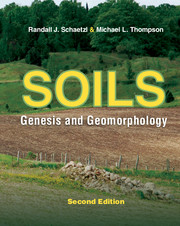5 - Basic Concepts: Soil Chemistry
Published online by Cambridge University Press: 12 January 2024
Summary
Soils are multiphase systems in which solids, liquids, gases, and colloids collectively interact. The solids in soils are crystalline or poorly crystalline minerals as well as organic matter. The liquid is water. Gases include nitrogen (N2), oxygen (O2), carbon dioxide (CO2), methane (CH4), and water vapor (H2O). And colloids are minerals, humified organic matter, and many kinds of microorganisms that are generally <1 μm in diameter. Although some chemical and biochemical reactions in soils occur in a single, homogeneous phase, e.g., the liquid or solid phase, most reactions occur at the boundary between two phases, e.g., at the gas–liquid interface or at the liquid–colloid interface. Alternatively, they could be coupled with reactions that occur in more than one phase. Because both the architecture and the biological activity of soils vary by horizon and landscape position, the speed and direction of chemical and biochemical reactions also vary in complex and fascinating ways.
The Liquid Phase in Soils
Most chemical reactions in soils occur in the liquid phase, i.e., the soil solution, or at the interface between the liquid and solid phases. The soil solution consists of water in which cations, anions, ion pairs, small organic molecules, and gas molecules are dissolved and in which colloids are suspended. The chemical composition of the soil solution usually varies seasonally and depends on how much water is in the soil, on the minerals present, and on plant nutrient uptake. In many soils, Ca2+, Mg2+, Na+, and K+ (referred to as base cations) are the most abundant cations, whereas the dominant anions include HCO3-, Cl-, and SO42- (Table 5.1). Other cations and anions are present at relatively low concentrations. Most trace metals in solution, such as Fe or Al, occur in a variety of species that are determined by the pH of the solution and by the abundance of complexing anions or ligands. Soluble complexes of ions may be charged, e.g., Fe(OH)2+ or uncharged, e.g., CaCO3°.
The likelihood that any soluble species will react with another (i.e., its chemical activity) depends on its charge, size, and the concentrations of all other species that are in the solution (indexed by the solution's ionic strength). Ions shield one another from participating in chemical reactions, so the activity of any particular ion decreases as the ionic strength of the solution increases.
- Type
- Chapter
- Information
- SoilsGenesis and Geomorphology, pp. 71 - 84Publisher: Cambridge University PressPrint publication year: 2015



